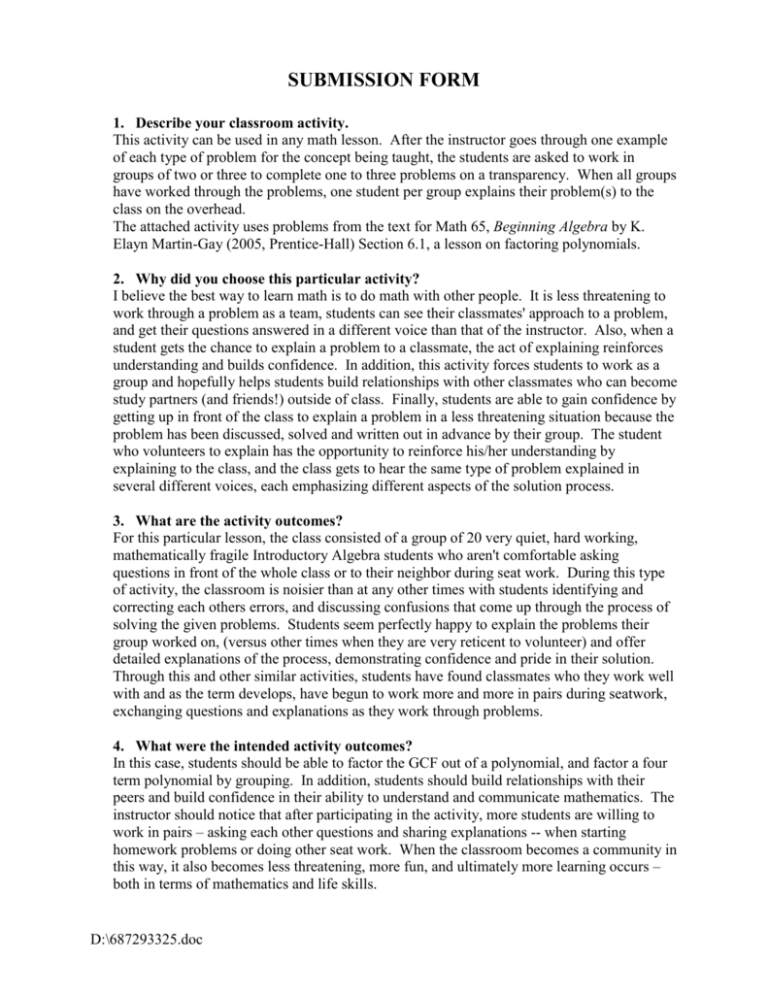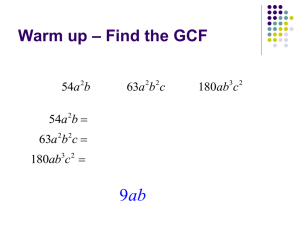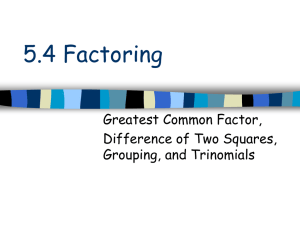Submission 14
advertisement

SUBMISSION FORM 1. Describe your classroom activity. This activity can be used in any math lesson. After the instructor goes through one example of each type of problem for the concept being taught, the students are asked to work in groups of two or three to complete one to three problems on a transparency. When all groups have worked through the problems, one student per group explains their problem(s) to the class on the overhead. The attached activity uses problems from the text for Math 65, Beginning Algebra by K. Elayn Martin-Gay (2005, Prentice-Hall) Section 6.1, a lesson on factoring polynomials. 2. Why did you choose this particular activity? I believe the best way to learn math is to do math with other people. It is less threatening to work through a problem as a team, students can see their classmates' approach to a problem, and get their questions answered in a different voice than that of the instructor. Also, when a student gets the chance to explain a problem to a classmate, the act of explaining reinforces understanding and builds confidence. In addition, this activity forces students to work as a group and hopefully helps students build relationships with other classmates who can become study partners (and friends!) outside of class. Finally, students are able to gain confidence by getting up in front of the class to explain a problem in a less threatening situation because the problem has been discussed, solved and written out in advance by their group. The student who volunteers to explain has the opportunity to reinforce his/her understanding by explaining to the class, and the class gets to hear the same type of problem explained in several different voices, each emphasizing different aspects of the solution process. 3. What are the activity outcomes? For this particular lesson, the class consisted of a group of 20 very quiet, hard working, mathematically fragile Introductory Algebra students who aren't comfortable asking questions in front of the whole class or to their neighbor during seat work. During this type of activity, the classroom is noisier than at any other times with students identifying and correcting each others errors, and discussing confusions that come up through the process of solving the given problems. Students seem perfectly happy to explain the problems their group worked on, (versus other times when they are very reticent to volunteer) and offer detailed explanations of the process, demonstrating confidence and pride in their solution. Through this and other similar activities, students have found classmates who they work well with and as the term develops, have begun to work more and more in pairs during seatwork, exchanging questions and explanations as they work through problems. 4. What were the intended activity outcomes? In this case, students should be able to factor the GCF out of a polynomial, and factor a four term polynomial by grouping. In addition, students should build relationships with their peers and build confidence in their ability to understand and communicate mathematics. The instructor should notice that after participating in the activity, more students are willing to work in pairs – asking each other questions and sharing explanations -- when starting homework problems or doing other seat work. When the classroom becomes a community in this way, it also becomes less threatening, more fun, and ultimately more learning occurs – both in terms of mathematics and life skills. D:\687293325.doc X I understand that by submitting an entry for this contest, my submission may be posted on the Retention Website in the future for other faculty to use as a resource in their class. (I can't really check the box, but I agree. My lesson plan and the overheads used for the activity are pasted below. Thanks. D:\687293325.doc Math 65: Introductory Algebra Examples from course text:Beginning Algebra, K.Elayn Martin-Gay (2005, Prentice-Hall) Section 6.1 The GCF and Factoring by Grouping Time Period Approximately 75 minutes Objectives Students will be able to factor the greatest common factor (GCF) from a polynomial. Students will be able to factor a four term polynomial by grouping. Students will use each other as a resource to ask and answer questions. Students will communicate the mathematical procedure of GCF problems to the class. Bring Transparencies with problems sets from 6.1 using Resource Manual, p. 279-280 (attached at the end of this lesson). 10 overhead pens Activities 10 min 1. Warm-up: Make a Factor Tree for following numbers (do example) Then write each number as a product of prime factors. (Volunteers make trees on board.) 24 = 2 x 2 x 2 x 3 36 = 2 x 2 x 3 x 3 28 = 2 x 2 x 7 50 = 2 x 5 x 5 44 = 2 x 2 x 11 60 = 2 x 2 x 3 x 5 What is the GCF of 24 and 60? (2 x 2 x 3 = 12) etc. Mental Math p. 359 5 min 2. Show how to find the GCF of expressions involving variables too: (y4, y2, y5) (x5, x6, x8, x3) what do they all have in common? 5 min 3. Now, find GCF of coefficient and variable at the same time: 8x3, 10x2, -4x 5a2b3, 15a4b2, 25a3b4 5 min 4. Go back and replace comma with (+) signs and we have a polynomial Factor out the GCF. 5 min 5. Factoring a 4-term polynomial by grouping: xy 2 x 3 y 6 x( y 2) 3( y 2) ( y 2)( x 3) 4ax 4ab 2bx 2b 2 4a( x b) 2b( x b) ( x b)(4a 2b) 30 min 6. Ask students to split into groups of two or three. Give each group a transparency with 2 GCF problems and one 4-term grouping problem and a pen. Ask students to solve in groups and write answer on transparency. Circulate to answer questions. When all groups have finished, have one member of each group explain their problem set at overhead. If a group finishes early, its members may start the homework assignment. As students explain problems, be sure to note: 1) when can't factor 2)when "only" 1 is left behind 3) when need to factor out a negative 15 min 7. Start homework. Encourage students to continue to work with their group members asking and answering each others questions, while instructor circulates to help also. D:\687293325.doc Section 6.1 The GCF and Factoring by Grouping 4x 2 4x 3a 4 b 2 2a 3b 3 5a 3b 2 Factor the following four-term polynomial by grouping. 3x 2 6 xy 5x 10 y D:\687293325.doc Section 6.1 The GCF and Factoring by Grouping 9x2 6x 3 3x 2 y 3 9 xy 2 Factor the following four-term polynomial by grouping. ab b 3a 3 D:\687293325.doc Section 6.1 The GCF and Factoring by Grouping 3x 3 y 6 x 2 y 2 27 xy 3 y 4 6 y 3 15 y 2 3 y 21 Factor the following four-term polynomial by grouping. 2 x 4 xy 2 y D:\687293325.doc Section 6.1 The GCF and Factoring by Grouping 3 4 5 2 3 x x x x 2 2 5 x 4 10 x 3 5 x 2 Factor the following four-term polynomial by grouping. 5 x 3 x 2 15 x 3 D:\687293325.doc Section 6.1 The GCF and Factoring by Grouping 7 x 5 y 4 14 x 3 y 21x 2 y 2 4a 4 12a 2 8a 8 Factor the following four-term polynomial by grouping. 12 x 3 21x 2 20 x 35 D:\687293325.doc Section 6.1 The GCF and Factoring by Grouping 12 x 4 9 x 3 6 x 2 3( x 2 4 y) 2 x( x 2 4 y) Factor the following four-term polynomial by grouping. 3 y 9 xy 3 x D:\687293325.doc








